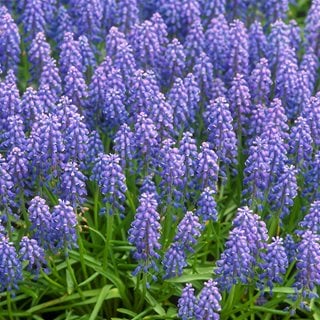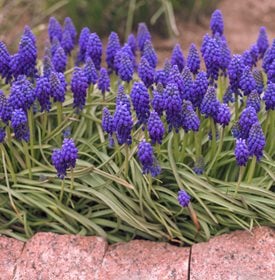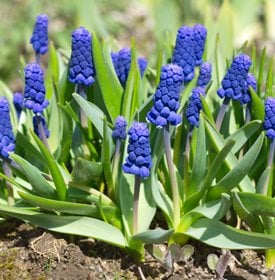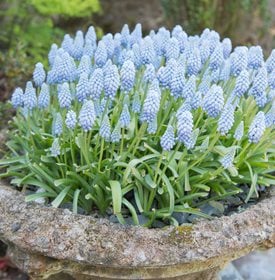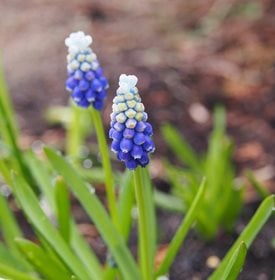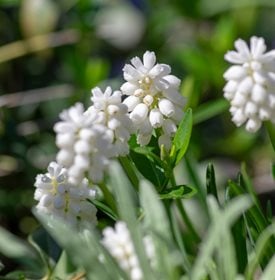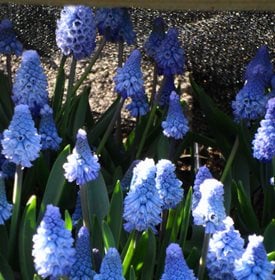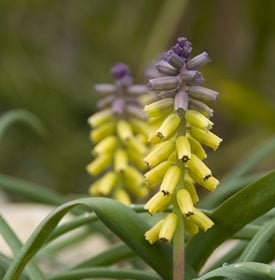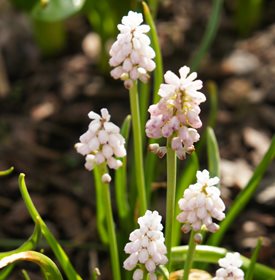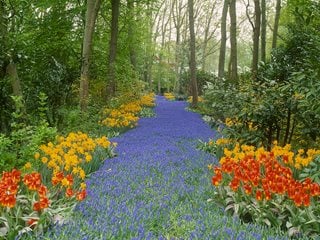How to Grow Grape Hyacinth
Diminutive muscari flowers pack a big punch in the spring gardenGrape hyacinth is named for the tight clusters of rounded florets that resemble tiny grapes. This easy to grow bulb needs little care and rewards with early season color that complements many other spring bloomers such as tulips and daffodils.
Muscari makes a versatile addition to the landscape. Use in borders, rock gardens, as pathway edging, or in containers. Naturalize underneath deciduous trees and shrubs, in woodlands, and meadow gardens. Indoors, the sweetly fragrant blooms can be enjoyed as cut flowers or forced for winter bloom. Here’s how to grow and use this reliable hardy bulb.
On this page: Basics | Planting | Care and Maintenance | Pictures | Design Ideas
On this page:
BASICS
Botanical name:
Muscari spp.
Zones:
3-9
Native region:
Mediterranean and Southwest Asia
Height/Spread:
Upright spreading habit, 4 to 10 inches tall and 1 to 6 inches wide
Exposure:
Full sun to partial shade
Bloom Time:
Early to late spring, depending on the variety and region
Flowers:
Tiny clusters of bell-shaped flowers 2 to 3 inches long open sequentially from the bottom up. Flower head tips can be pointed or rounded. Blooms have a light fruity scent, occurring in shades of blue, purple, pink, white, yellow, or bicolors.
Foliage:
Foliage is dense and grass-like. Plants flower in spring, going dormant in summer, with foliage reappearing in fall.
Toxicity:
Grape hyacinth is non-toxic to pets and children.
Is grape hyacinth invasive?
Bulbs naturalize readily and may be somewhat invasive in certain regions (see where). Grow in containers to control spread.
Is grape hyacinth deer resistant?
Muscari is considered deer-resistant, though any plant may be susceptible to deer browsing if other food sources are scarce.
PLANTING GRAPE HYACINTH
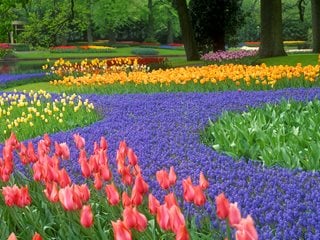
Muscari growing with other spring bulbs at the Keukenhof Gardens in Holland. Photo by: Janet Loughrey
When to plant:
Bulbs can be purchased from late summer to mid fall for fall planting.
Where to plant:
Plant in a site that receives adequate light and has well-draining soil.
How to plant:
Loosen soil in planting area and amend with compost or other organic matter. Place bulbs 3 to 4 inches deep and 2 to 3 inches apart with the pointed end up and the flat root end facing down. Place in drifts of at least 25 bulbs for the greatest impact. For larger areas, scatter the bulbs for a more natural look. Water well after planting.
Planting grape hyacinth in pots:
Make sure pots have adequate drainage holes. Use a high quality all-purpose potting soil. Mass in groups of 12 to 24 for the best effect.
Forcing bulbs indoors:
Pre-chill bulbs in a refrigerator, unheated garage, or basement for 10 to 12 weeks at temperatures between 35 to 45 degrees F. Plant bulbs in potting soil or place in water using a forcing vase or other container. Keep in a cool place between 50 to 60 degrees F until leaves start to form. Move to a warm location that receives bright indirect light and keep bulbs moist until plants finish blooming.
For more on how to plant bulbs or tubers:
Bulbs 101: Planting and Storing Bulbs
GRAPE HYACINTH CARE
Soil:
Grape hyacinths are tolerant of most soil types. They perform best in amended, well-draining soil with a neutral pH.
Water:
Keep soil moderately moist but not soggy. Overwatering can cause bulb rot. Cease watering when plants go dormant in summer.
Fertilizer:
Grape hyacinth needs little or no supplemental fertilizer as long as soil is well-amended. At the time of planting, mix bone meal into the soil or use a fertilizer formulated for bulbs according to package instructions. If desired, bone meal or fertilizer can be reapplied annually in fall on the soil surface, but is not necessary.
After-bloom care:
Remove spent flower stalks before they set seed to reduce invasive spreading.
Dividing:
Overcrowding can result in fewer blooms. Divide every 3 to 5 years. When plants are dormant, dig up bulbs, separate and replant at the proper spacing.
Diseases and Pests:
When planted in the right conditions, grape hyacinth has few pests or diseases. Pests include aphids and spider mites. The most common disease is yellow mosaic virus.
GRAPE HYACINTH VARIETIES
Grape hyacinth alternatives:
Substitutes for grape hyacinth include Spanish bluebells (Hyacinthoides hispanica) and Siberian squill (Scilla siberica).
DESIGNING WITH GRAPE HYACINTH
For borders and landscapes: Grape hyacinth naturalizes well in woodland settings, open meadows, garden beds, rock gardens, and underneath deciduous trees and shrubs.
For slopes and hillsides: Plant underneath deciduous trees or shrubs that grow along a slope, or combine with other spring blooming bulbs and perennials.
For containers: Grape hyacinth can be grown outdoors in containers or indoors for winter forcing.
There are many ways to incorporate cyclamen into your home and landscape. Here’s how:
- Force grape hyacinth indoors alongside other bulbs such as fragrant narcissus and hyacinth for a cheerful display that is sure to beat the winter blues.
- Naturalize in a rock garden in combination with creeping phlox, gold alyssum, dwarf iris, and narcissus for a stunning early season show.
- Mass underneath early blooming trees and shrubs such as cherry, magnolia, dogwood, azalea, and forsythia for a carpet of color.
- Edge a pathway, alternating clumps of blue grape hyacinth with ‘Tete a Tete’ narcissus or other daffodil for a complementary color display.
- Naturalize in a meadow or woodland setting alongside other bulbs, wildflowers and natives that bloom at different times for a succession of color through the spring season.
Companion plants for grape hyacinth:
Grape hyacinth goes well with many other spring bloomers, including tulip, daffodil, hellebore, bergenia, bleeding heart, dwarf iris, phlox, and lungwort.
RELATED:
Top 20 Spring-Blooming Bulbs
Bulbs for Warm Climate Gardens
Growing Hyacinth Flowers
All-Star Spring Flowers

